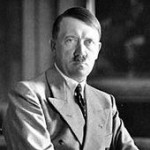
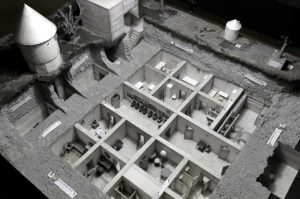 I read yesterday, that Adolf Hitler went into his underground bunker, known as the Führerbunker, with his mistress, Eva Braun on January 16, 1945. It was a coward’s move, so as not to have to face the Russians when they marched into town. He left his men to finish out the war in a losing battle, and when they wanted to surrender, they were rewarded with death. They were considered cowards, and yet Hitler made his last trip above ground on April 20, 1945, his 56th birthday. He took that opportunity, in the ruined garden of the Reich Chancellery, to award the Iron Cross to boy soldiers of the Hitler Youth, and then he retreated back to the safety of his bunker. On April 28th, Hitler learned that Reichsführer, SS Heinrich Himmler, who had left Berlin on April 20th was trying to discuss surrender terms with the Western Allies through Count Folke Bernadotte. To Hitler this was treason, and he was enraged. He ordered Himmler’s arrest. He also had Hermann Fegelein, Himmler’s SS representative at Hitler’s Headquarters in Berlin, shot. Those men were doing their best to stay alive, and Hitler sat in the safety of his bunker calling them traitors and cowards. Hitler’s bunker, while not elegant by any standard, was quite comfortable. He and Eva were well protected until the day they took their own lives on April 30, 1945…one day after their April 29th
I read yesterday, that Adolf Hitler went into his underground bunker, known as the Führerbunker, with his mistress, Eva Braun on January 16, 1945. It was a coward’s move, so as not to have to face the Russians when they marched into town. He left his men to finish out the war in a losing battle, and when they wanted to surrender, they were rewarded with death. They were considered cowards, and yet Hitler made his last trip above ground on April 20, 1945, his 56th birthday. He took that opportunity, in the ruined garden of the Reich Chancellery, to award the Iron Cross to boy soldiers of the Hitler Youth, and then he retreated back to the safety of his bunker. On April 28th, Hitler learned that Reichsführer, SS Heinrich Himmler, who had left Berlin on April 20th was trying to discuss surrender terms with the Western Allies through Count Folke Bernadotte. To Hitler this was treason, and he was enraged. He ordered Himmler’s arrest. He also had Hermann Fegelein, Himmler’s SS representative at Hitler’s Headquarters in Berlin, shot. Those men were doing their best to stay alive, and Hitler sat in the safety of his bunker calling them traitors and cowards. Hitler’s bunker, while not elegant by any standard, was quite comfortable. He and Eva were well protected until the day they took their own lives on April 30, 1945…one day after their April 29th 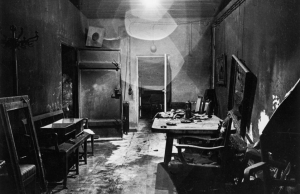
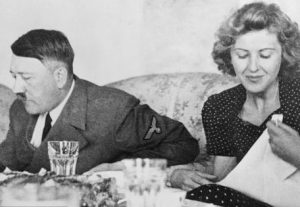 marriage. Their death came by cyanide poisoning, with Hitler’s accompanied by a self inflicted gunshot wound to the head. They did not want to face the possibility of a trial for the many war crimes he was responsible for.
marriage. Their death came by cyanide poisoning, with Hitler’s accompanied by a self inflicted gunshot wound to the head. They did not want to face the possibility of a trial for the many war crimes he was responsible for.
In what was proving to be a crumbling empire, Hitler’s death camp soldiers knew they too, were in trouble, the day after he went underground. On January 17, 1945, the Russians were approaching Auschwitz. The decision was made to evacuate most of its population and send them on a death march. It was the largest and the most notorious of the death marches. Just nine days before the Soviets arrived at the death camp at Auschwitz, the SS marched nearly 60,000 prisoners out of the camp toward Loslau, 39 miles away. There, they were put on freight trains to other camps. Approximately 15,000 prisoners died on the way, which is why it was called a death march. Loslau recorded a freezing -4°F and lower at the time the prisoners were arriving. Residents tried to help the prisoners, and many prisoners regained freedom between Auschwitz and Loslau, as the residents helped them escape. The prisoners who were left at the camp were liberated on 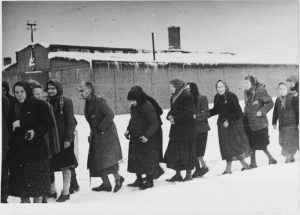
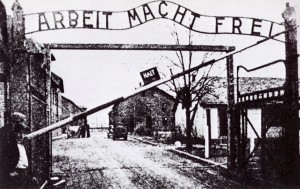 January 27, 1945, which is a day now commemorated as International Holocaust Remembrance Day. In years after the Holocaust, survivors, such as Primo Levi, Viktor Frankl, and Elie Wiesel, wrote memoirs of their experiences in Auschwitz, and the camp became a dominant symbol of the Holocaust. In 1947, Poland founded the Auschwitz-Birkenau State Museum on the site of Auschwitz I and II, and in 1979, it was named a UNESCO World Heritage Site.
January 27, 1945, which is a day now commemorated as International Holocaust Remembrance Day. In years after the Holocaust, survivors, such as Primo Levi, Viktor Frankl, and Elie Wiesel, wrote memoirs of their experiences in Auschwitz, and the camp became a dominant symbol of the Holocaust. In 1947, Poland founded the Auschwitz-Birkenau State Museum on the site of Auschwitz I and II, and in 1979, it was named a UNESCO World Heritage Site.


3 Responses to The Coward’s Way Out